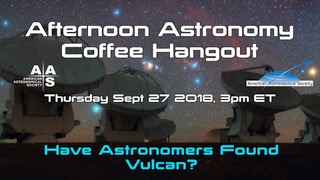Afternoon Astronomy Coffee Hangout 27 September
Carol Christian STScI
"Is there a Planet Vulcan? Maybe..."
What would the planet Vulcan be like? It might be like the "super-Earth" planet orbiting a nearby star (16 light years) called HD 26965. The planet is only twice the size of Earth and the parent star is much like the sun. The planet orbits the star in a mere 42 days — but it is just inside the habitable zone where life might form. The star is a little smaller and cooler and has other attributes similar to the Sun. The object was found with the Dharma Endowment Foundation Telescope (DEFT), a 50-inch telescope located atop Mt. Lemmon in southern Arizona near Tucson. The astronomers think the planet just might be suitable for life and even an advanced civilization. Several publications about Star Trek actually referred to this planetary system as the home of Mr. Spock known by its other name, 40 Eridani.
Join Tony Darnell and Carol Christian during Afternoon Astronomy Coffee on Thursday, 27 September at 3:00 pm Eastern Daylight Time (19:00 UTC) as they discuss with investigator Jian Ge (University of Florida) and team member Matthew Muterspaugh (Tennessee State University) about the Dharma Survey discovery and the interesting characteristics of the HD 26965 system as well as the survey itself.
- Join the Hangout on YouTube
- The Afternoon Astronomy Coffee series may be found on the Deep Astronomy website
- The link for the latest Afternoon Astronomy Coffee will be announced on the Deep Astronomy Facebook page
What Are "Afternoon Astronomy Coffee" and "Future in Space" Hangouts?
"Future In Space” and "Afternoon Astronomy Coffee" Hangouts are part of a weekly series, held every Thursday, that also includes a segment called "Footsteps to Mars." We bring the the latest research in astronomy, highlights from the future of space astronomy and astronautics planning, as well as updates on the exploration of Mars to you every week via Hangouts on Air. With the sponsorship of both the American Astronomical Society and the American Astronautical Society, our hosts Tony Darnell, Carol Christian, Alberto Conti, and Harley Thronson examine today's breakthroughs in research and peer into the unfolding possibilities of what we may learn about the universe and Mars exploration. We join with members of the American Astronomical Society to chat, in an informal online setting modeled after "science coffee" events held in universities and research organizations across the country. We will examine what we hope to learn about exoplanets, black holes, the early universe, quasars, and life in the universe along with what technologies might help us — and reflect upon the scientific endeavors occurring today that uncover amazing astrophysics and lay the groundwork for studies to come.
We will also explore the technology and engineering used today as well as possibilities for future space travel and research with members of both societies, and probe what our future in space may look like and how we might get there. We will examine the underlying technologies of space telescopes, orbiters, landers, and human space vehicles now and in the years to come. We will delve into topics that help us understand the possibilities and limitations of human space flight and eventual human colonization of other worlds.
We hope you can join us each month as we bring experts from both societies — people who think about and plan for our future in space — to your computer, tablet, or smartphone. We invite you to bring your questions and comments and get ready to learn about the amazing possibilities for the future of space astronomy and exploration.


